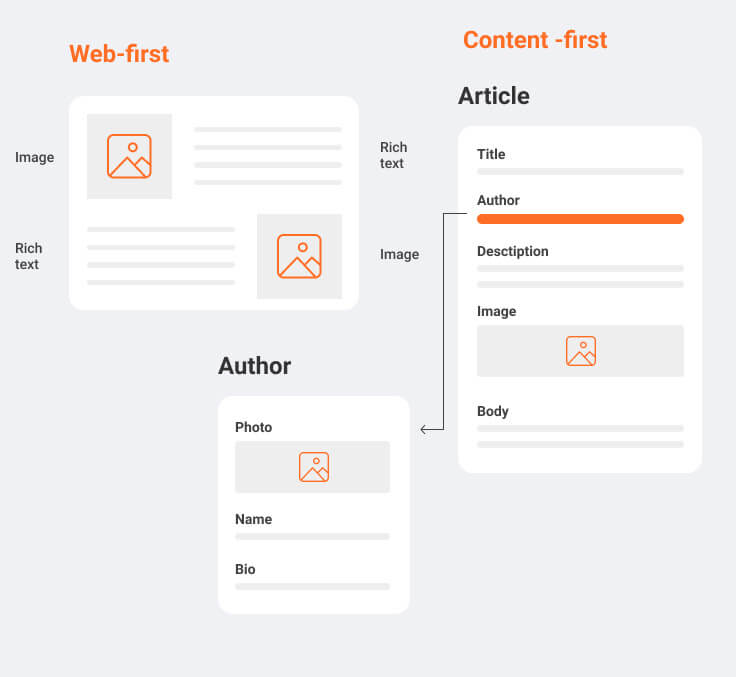- Choosing the right Headless CMS
- Process to choose Headless CMS
- 1. Learn About Headless CMS and Its Architecture
- 2. Pinpoint Your Business Concerns
- 3. Identify The Needs of All Your Team Members
- 4. Do an In-Depth Budget Analysis
- 5. List Out Headless CMS Providers
- 6. Analyze The Overall Headless CMS Solution
- 7. Figure out a suitable proposal from your headless CMS Provider
- Further Readings on Headless CMS
Choosing the right Headless CMS
We are all aware of the major shifts in the Content Management System (CMS) industry. As the demand of individuals and enterprises grows, so does the content and its management. To fulfill it, organizations go through digital transformation.
Enterprises look for ways to become more agile and deliver satisfactory digital experiences. Sooner or later, they realize content management is one of the factors that is holding them back. So, they decide to shift to headless CMS. If you are one of them, this guide will help you learn how to choose the right headless CMS.
Process to choose Headless CMS
Here is the 7- steps process that will help you choose headless cms for your business.
1. Learn About Headless CMS and Its Architecture
If you are only aware of traditional CMS, then it is necessary that you understand headless CMS. As moving to a headless CMS requires some shifts. These shifts depend on how you think about your upcoming solution.
Here are some approaches that will help you get more clarity about choosing a headless content management system.
Difference Between Monolithic and Microservice Architecture
A traditional CMS is a combination of content management and presentation in a single solution. It controls the way content is presented to a website using templates. The result is a big monolithic architecture in which CMS is at the center.
Whereas the headless CMS perfectly fits the microservice architecture. Because the headless content management system manages the content and delivers it via APIs. That means, through headless CMS, content can be delivered to any channel.
Microservice headless architecture is very popular among developers as they can use any development language and front-end framework.
Switching to headless without prior knowledge can turn your days into a nightmare. So, it is of utmost necessity to have complete knowledge about Headless CMS before moving further. You can refer to our ‘Complete Guide on Headless CMS – 2021’ for further knowledge on Headless CMS.
Difference Between Web First and Content First Approach
Traditional CMS was designed specifically for the web. It was developed for web-specific concepts such as sitemap, websites, and web pages. They mainly focus on giving control over the design. Thus, a traditional CMS follows a web-first approach
Whereas, on the other hand, Headless CMS follows a content-first approach. Headless architecture starts with content modeling and lets you define a proper structure for the content. So, the same piece of content can be reused.
2. Pinpoint Your Business Concerns
Sorting out business requirements is the most crucial factor in choosing a Headless CMS. Because eventually, it’s all about getting your requirements fulfilled.
Below are some business cases & requirements for choosing headless CMS.
- To implement modern technology for a competitive digital experience.
- For a personalized omnichannel experience.
- To get higher agility, productivity, and consistency of brand.
- To increase the efficiency of content operations.
- For making your business future-proof.
3. Identify The Needs of All Your Team Members
Though the decision is always taken by the IT department, it is important to fulfill the requirements of every team getting in touch with the headless CMS. The teams that closely work with headless CMS are:
- Technical Team
- Content Team
- Business Team
Essential Needs For The Technical Team
A technical team usually consists of front-end developers, Back-end developers, Enterprise Architect, DevOps, Administrators, Security Specialists, etc.
Here are some of the key criteria that are important for the technical team.
- Deployment options such as self-hosted, PaaS, or SaaS.
- Datacenter locations when choosing a SaaS Headless CMS.
- API response time to speed up your Headless CMS application.
- Continuous integration & Continuous Deployment.
- High level of customization and extensibility.
- Security and privacy are as per the industry standards.
Essential Needs For The Content Team
The IT department often makes the mistake of choosing a headless CMS based only on the technical requirements. When that chosen headless CMS is placed before actual users (Content Team), they realize their requirements are not met accurately.
The criteria that are important in headless cms for the content team are:
- Easy to use
- Easy integration with tools and plugins
- Manual copy-pasting and synchronization
- Less dependability on developers
- No content redundancy
- Work across multiple systems
- Ability to cope with the content lifecycle
Essential Needs For The Business Team
The business team consists of Marketers, Branding Specialists, Business Developers, subject experts, etc.
The criteria of business teams are:
- Low reliability on developers for minor changes.
- Headless CMS should focus on managing content independently.
- It should follow a content-first approach.
- Easy collaboration with content and tools.
4. Do an In-Depth Budget Analysis
Before switching to Headless CMS, it is important to analyze the overall cost and budget. The total cost of ownership includes the following criteria:
- The upfront cost of Headless CMS
- Overall implementation costs
- Migration cost from existing CMS
- Ongoing development costs
- Hosting Cost
- Maintenance cost
To manage your cost-effectively, you can choose headless CMS based on their pricing model. The most common pricing models and their costs are as mentioned below.
- Open source headless CMS – $0
- Low-cost & Team plan – $15 to $500
- Enterprise headless CMS – $999 to $10,000+
There is a huge difference between the price gap of each model. Such variation in pricing can affect the overall business and its growth. Thus, it is very important to set a budget and model before selecting a headless CMS.
5. List Out Headless CMS Providers
Now you know your requirements and have a defined budget for your headless CMS, you should start looking for headless CMS vendors.
You can compare solutions based on their features and run an RFI (Request For Information) process.
To assist you, we have already sorted a list of the best Headless CMSes. You can directly compare and choose a suitable one from below.
Read more about Top 20 Headless CMS.
6. Analyze The Overall Headless CMS Solution
When you shortlist vendors you will have a handful of CMS providers. And, most of them will fit your requirements. You need to make sure that they meet the needs of all the developers, marketers, and business users.
The best way to evaluate a headless CMS product is to create a simple proof of concept. It will lead you to the clarity of questions such as:
- How flexible is the API of headless CMS?
- Is there any training program for developers?
- At what time is the support available from the vendor?
- How comfortable will the new headless solution be?
- How will it be integrated with your existing system?
- When can you start using the CMS?
- What are the security measures of the chosen headless CMS?
Answering such questions can help you further simplify the selection process.
7. Figure out a suitable proposal from your headless CMS Provider
Now you have simplified headless CMS options for your business or organization. To finalize a perfect match, you need to encounter a mix of the following matrix.
- Overall Functionality
- Number of Users
- Number of projects
- Content Items
- Number of API calls
- Bandwidth
- Storage Space
- Implementation time
- Employee Training
- Onboarding Process
- Customer Support
- Service Level Agreements (SLAs)
- Fit to your company culture
This 7 step method will help you choose the right headless CMS. We hope you choose the best one for yourself. In case if you face issues, we are here to help you out. Contact us for Headless CMS-related services.
Further Readings on Headless CMS
Future of CMS With Facts, Figures, Trends, and Statistics
COMMENT
No Comments found.
DETAILED INDUSTRY GUIDES
Software Development - Step by step guide for 2021 and
beyond | OpenXcell
Learn everything about Software Development, its types, methodologies, process outsourcing with our complete guide to software development.
Headless CMS - The complete guide for 2021 | OpenXcell
Learn everything about Headless CMS along with CMS, its types, pros & cons as well as use cases, and real-life examples in a complete guide.
Mobile App Development - Step by step guide for 2021 and beyond | OpenXcell
Building your perfect app requires planning and effort. This guide is a compilation of best mobile app development resources across the web.
DevOps - A complete roadmap for software transformation | OpenXcell
What is DevOps? A combination of cultural philosophy, practices, and tools that integrate and automate between software development and the IT operations team.
GET QUOTE
INSIGHTS INTO TECH
The inception of ChatGPT in 2022 marked the wide-scale adoption of Artificial Intelligence in application development. In the field of creating mobile apps, AI-powered tools and frameworks have become indispensable…
Read more...
Introduction Most industries have turned to AI to stay ahead of the competition in the evolving tech landscape. The construction industry is no stranger to this trend. The advent of…
Read more...
Introduction Digital transformation needs no introduction; it is evolving as a norm in many industries. The paradigm transition it brings to the retail landscape is evident from the latest predictions.…
Read more...










